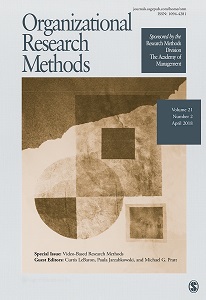Academic articles
Practitioner articles
Working papers
Books
Book chapters
Case studies
Other publications
Subject(s)
Ethics and social responsibility
Keyword(s)
Corporate social responsibility, corporations, environmental sustainability, human resources, organizational learning, performance metrics, socially responsible business, transparency
JEL Code(s)
M000
Also available in Portuguese: Mensurando impacto: Sustentabilidade empresarial 2.0.
Subject(s)
Human resources management/organizational behavior
Keyword(s)
Multivariate analysis, computational modeling, team diversity, categorization salience, leadership
It is increasingly recognized that team diversity with respect to various social categories (e.g., gender, race) does not automatically result in the cognitive activation of these categories (i.e., categorization salience), and that factors influencing this relationship are important for the effects of diversity. Thus, it is a methodological problem that no measurement technique is available to measure categorization salience in a way that efficiently applies to multiple dimensions of diversity in multiple combinations. Based on insights from artificial intelligence research, we propose a technique to capture the salience of different social categorizations in teams that does not prime the salience of these categories. We illustrate the importance of such measurement by showing how it may be used to distinguish among diversity-blind responses (low categorization salience), multicultural responses (positive responses to categorization salience), and intergroup biased responses (negative responses to categorization salience) in a study of gender and race diversity and the gender by race faultline in 38 manufacturing teams comprising 239 members.
With permission of SAGE Publishing
Volume
19
Journal Pages
433–474
Subject(s)
Information technology and systems; Technology, R&D management
Keyword(s)
Change management, IT, benefits dependency network (BDN), digitalization
JEL Code(s)
O32, O33
Given all the attention that “digital” is getting at the moment, you would be forgiven for thinking that it is somehow new. In fact, the relentless drive to embrace digital technologies has been ongoing for many decades.
What also seems to have been forgotten are the lessons from these earlier attempts to leverage IT (remember that IT is a digital technology). Unfortunately, the history of IT investments in most organizations is far from stellar: Research over the years suggests that the overall failure rate of IT projects is around 70%. We know that when IT projects fail, it is usually not because the technology didn’t work (although this can sometimes be the case), but because the changes required at an organizational and employee level weren’t managed effectively. Quite simply, adding technology does not automatically confer expected benefits; these benefits have to be unlocked and this can only happen through achieving organizational changes.
ISSN (Print)
0017-8012
Subject(s)
Economics, politics and business environment
Keyword(s)
Economics, Econometrics and Finance
Secondary Title
An economist in the real world: The art of policy making in India
Journal Pages
591–593
Subject(s)
Ethics and social responsibility
Keyword(s)
Corporate social responsibility, business ethics, corruption in particular, governance and compliance, intercultural/cross-cultural management, cross-cultural ethics, challenges of internationalization/globalization
This four-part case series can be used to discuss business ethics, compliance/governance, integrity management, reacting to and preparing against corruption in the context of internationalization and allows to also briefly touch upon the issue of Corporate Social Responsibility (CSR). Case (A) describes a challenge IKEA was facing, while trying to enter Russia in 2000. The company was preparing to open its first flagship store on the outskirts of Moscow, only the first of several planned projects. After substantial investments in infrastructure and logistics, IKEA focused on marketing, but quickly faced a sudden complication. Its major ad campaign in the Moscow Metro with the slogan “[e]very 10th European was made in one of our beds” was labeled “tasteless”. IKEA had to stop the campaign because it “couldn’t prove” the claim. Soon Lennart Dahlgren, the first general manager of IKEA in Russia must have realized that the unsuccessful ad campaign was going to be the least of his problems: A few weeks before the planned opening, the local utility company decided not to provide their services for the store if IKEA did not pay a bribe. What should IKEA and Lennart Dahlgren do? Was there any alternative to playing the game the Russian way, and paying? The subsequent cases (B), (C), and (D) describe IKEA’s creative response to the challenges described in case (A), and then report about new challenges with alleged corruption within IKEA and in the legal environment, and finally raise the question whether IKEA can be considered to have a social responsibility to fight corruption on a societal level in order to build the platform for its own operation in Russia.
| buy now | buy now | buy now |
Subject(s)
Ethics and social responsibility
Keyword(s)
Corporate social responsibility, business ethics, corruption in particular, governance and compliance, intercultural/cross-cultural management, cross-cultural ethics, challenges of internationalization/globalization
This four-part case series can be used to discuss business ethics, compliance/governance, integrity management, reacting to and preparing against corruption in the context of internationalization and allows to also briefly touching upon the issue of Corporate Social Responsibility (CSR). Case (A) describes a challenge IKEA was facing, while trying to enter Russia in 2000. The company was preparing to open its first flagship store on the outskirts of Moscow, only the first of several planned projects. After substantial investments in infrastructure and logistics, IKEA focused on marketing, but quickly faced a sudden complication. Its major ad campaign in the Moscow Metro with the slogan “[e]very 10th European was made in one of our beds” was labeled “tasteless”. IKEA had to stop the campaign because it “couldn’t prove” the claim. Soon Lennart Dahlgren, the first general manager of IKEA in Russia must have realized that the unsuccessful ad campaign was going to be the least of his problems: A few weeks before the planned opening, the local utility company decided not to provide their services for the store if IKEA did not pay a bribe. What should IKEA and Lennart Dahlgren do? Was there any alternative to playing the game the Russian way, and paying? The subsequent cases (B), (C), and (D) describe IKEA’s creative response to the challenges described in case (A), and then report about new challenges with alleged corruption within IKEA and in the legal environment, and finally raise the question whether IKEA can be considered to have a social responsibility to fight corruption on a societal level in order to build the platform for its own operation in Russia.
| buy now | buy now | buy now |
Subject(s)
Ethics and social responsibility
Keyword(s)
Corporate social responsibility, business ethics, corruption in particular, governance and compliance, intercultural/cross-cultural management, cross-cultural ethics, challenges of internationalization/globalization
This four-part case series can be used to discuss business ethics, compliance/governance, integrity management, reacting to and preparing against corruption in the context of internationalization and allows to also briefly touching upon the issue of Corporate Social Responsibility (CSR). Case (A) describes a challenge IKEA was facing, while trying to enter Russia in 2000. The company was preparing to open its first flagship store on the outskirts of Moscow, only the first of several planned projects. After substantial investments in infrastructure and logistics, IKEA focused on marketing, but quickly faced a sudden complication. Its major ad campaign in the Moscow Metro with the slogan “[e]very 10th European was made in one of our beds” was labeled “tasteless”. IKEA had to stop the campaign because it “couldn’t prove” the claim. Soon Lennart Dahlgren, the first general manager of IKEA in Russia must have realized that the unsuccessful ad campaign was going to be the least of his problems: A few weeks before the planned opening, the local utility company decided not to provide their services for the store if IKEA did not pay a bribe. What should IKEA and Lennart Dahlgren do? Was there any alternative to playing the game the Russian way, and paying? The subsequent cases (B), (C), and (D) describe IKEA’s creative response to the challenges described in case (A), and then report about new challenges with alleged corruption within IKEA and in the legal environment, and finally raise the question whether IKEA can be considered to have a social responsibility to fight corruption on a societal level in order to build the platform for its own operation in Russia.
| buy now | buy now | buy now |
Subject(s)
Ethics and social responsibility
Keyword(s)
Corporate social responsibility, business ethics, corruption in particular, governance and compliance, intercultural/cross-cultural management, cross-cultural ethics, challenges of internationalization/globalization
This four-part case series can be used to discuss business ethics, compliance/governance, integrity management, reacting to and preparing against corruption in the context of internationalization and allows to also briefly touching upon the issue of Corporate Social Responsibility (CSR). Case (A) describes a challenge IKEA was facing, while trying to enter Russia in 2000. The company was preparing to open its first flagship store on the outskirts of Moscow, only the first of several planned projects. After substantial investments in infrastructure and logistics, IKEA focused on marketing, but quickly faced a sudden complication. Its major ad campaign in the Moscow Metro with the slogan “[e]very 10th European was made in one of our beds” was labeled “tasteless”. IKEA had to stop the campaign because it “couldn’t prove” the claim. Soon Lennart Dahlgren, the first general manager of IKEA in Russia must have realized that the unsuccessful ad campaign was going to be the least of his problems: A few weeks before the planned opening, the local utility company decided not to provide their services for the store if IKEA did not pay a bribe. What should IKEA and Lennart Dahlgren do? Was there any alternative to playing the game the Russian way, and paying? The subsequent cases (B), (C), and (D) describe IKEA’s creative response to the challenges described in case (A), and then report about new challenges with alleged corruption within IKEA and in the legal environment, and finally raise the question whether IKEA can be considered to have a social responsibility to fight corruption on a societal level in order to build the platform for its own operation in Russia.
| buy now | buy now | buy now |
Subject(s)
Marketing
Keyword(s)
Market research, customer satisfaction, statistics
JEL Code(s)
M310
Journal Pages
52–54
Subject(s)
Technology, R&D management
Keyword(s)
Big data, knowledge creation, insight, information, IT, competitive advantage
Journal Pages
19–25

